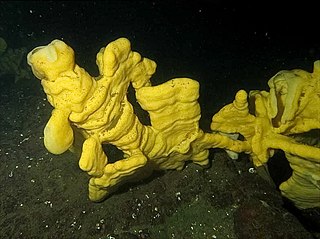
Sponges, the members of the phylum Porifera, are a basal animal clade as a sister of the Diploblasts. They are multicellular organisms that have bodies full of pores and channels allowing water to circulate through them, consisting of jelly-like mesohyl sandwiched between two thin layers of cells. The branch of zoology that studies sponges is known as spongiology.

Hexactinellid sponges are sponges with a skeleton made of four- and/or six-pointed siliceous spicules, often referred to as glass sponges. They are usually classified along with other sponges in the phylum Porifera, but some researchers consider them sufficiently distinct to deserve their own phylum, Symplasma. Some experts believe glass sponges are the longest-lived animals on earth; these scientists tentatively estimate a maximum age of up to 15,000 years.

The cloud sponge(Aphrocallistes vastus) is a species of sea sponge in the class Hexactinellida. It is a deep-water reef-forming animal. The species was first described by F.E. Schulze in 1886.

The Giant ostracod (Gigantocypris) or the Seed Shrimp is a genus of ostracod crustaceans in family Cypridinidae, and among the most well-known members of the class Ostracoda. Its members are extremely large for ostracods, measuring up to 3.2 cm (1.3 in) across, have a globular shape, are typically semi-transparent orange or reddish, and have relatively large mirror-like eyes that are used to locate their small animal prey. They are found worldwide in dark, deep and cold oceans.

Haliclona anonyma, the turret sponge or tubular fan sponge, is a species of demosponge. It is endemic to South Africa, where it occurs between the Cape Peninsula and Sodwana Bay.

Clathria prolifera, commonly known as red beard sponge, is a species of sea sponge in the family Microcionidae. It is native to shallow water habitats in the western Atlantic Ocean from Prince Edward Island southwards to Florida and Mexico, and possibly Brazil. In the twentieth century it also became established on the west coast of the United States.

Syllis ramosa is a species of polychaete worm in the family Syllidae. It is found in the deep sea where it lives within the tissues of a sponge. It was the first branching polychaete worm to be discovered, with each worm having a single head and multiple anuses.

The Tstsikamma Marine Protected Area is a marine protected area on the south coast of South Africa, in both the Western Cape and Eastern Cape. It is on the coast of the Tsitsikamma National Park, and is one of the oldest MPAs in the country. The MPA provides protection for marine habitat and wildlife, including birds and threatened and endangered fish species.

The Marine biodiversity of South Africa is the variety of living organisms that live in the seas off the coast of South Africa. It includes genetic, species and ecosystems biodiversity in a range of habitats spread over a range of ecologically varied regions, influenced by the geomorphology of the seabed and circulation of major and local water masses, which distribute both living organisms and nutrients in complex and time-variable patterns.

The Langebaan Lagoon Marine Protected Area is an inshore conservation region in the territorial waters of South Africa

The Malgas Island Marine Protected Area is an inshore conservation region in the territorial waters of South Africa in the entrance to Saldanha Bay on the west coast of the Western Cape province.

The Pondoland Marine Protected Area is an inshore conservation region in the territorial waters of South Africa
The Biodiversity of South Africa is the variety of living organisms within the boundaries of South Africa and its exclusive economic zone. South Africa is a region of high biodiversity in the terrestrial and marine realms. The country is ranked sixth out of the world's seventeen megadiverse countries, and is rated among the top 10 for plant species diversity and third for marine endemism.
Fibulia is a genus of sponges belonging to the family Dendoricellidae. The species of this genus are found in Southern South Hemisphere.

The Sixteen Mile Beach Marine Protected Area is a coastal conservation region in the territorial waters of South Africa, near Saldanha Bay on the Western Cape coast. The MPA is part of the West Coast National Park which is the core component of the Cape West Coast Biosphere Reserve.
Haliclona submonilifera, or the bubble bead sponge, is a deep-water demosponge from the continental shelf and slope off south-west Africa.
Hamacantha esperoides is a species of demosponge. It is commonly known as the fibrous sponge. It occurs off the southern and western coasts of South Africa, off the coast of Namibia, and off the southeast coast of South America.
Inflatella belli, or the gooseberry sponge, is a species of demosponge that appears to be restricted to the southern hemisphere, where it is widespread. It occurs from the coast of Namibia and the Indo-pacific, down to the Subantarctic and Antarctic regions.
Phorbas pustulosus, or the baseball glove sponge, is a species of demosponge known from the coast of South Africa and from the Patagonian Shelf.
Latrunculia biformis, the mud-clump sponge, is a widespread deep sea demosponge from the southern hemisphere.









